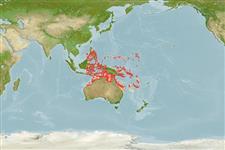>
Ovalentaria/misc (Various families in series Ovalentaria) >
Pomacentridae (Damselfishes) > Pomacentrinae
Etymology: Acanthochromis: Greek, akantha = thorn + Greek, chromis = a marine fish without identification, dealing with perch; cited by Plinius (Ref. 45335).
More on author: Bleeker.
Environment: milieu / climate zone / depth range / distribution range
экология
морской ассоциированный с рифами; немигрирующий; пределы глубины 1 - 65 m (Ref. 9710), usually 4 - 20 m (Ref. 90102). Tropical; 15°N - 26°S, 116°E - 169°E (Ref. 56301)
Western Pacific: Indonesia and the Philippines to northeastern Australia and Melanesia.
Size / Вес / Возраст
Maturity: Lm ? range ? - ? cm
Max length : 16.0 cm TL самец/пол неопределен; (Ref. 129178)
Краткое описание
определительные ключи | морфология | морфометрия
колючие лучи спинного плавника (общее число) : 17; членистые (мягкие) лучи спинного плавника (общее число) : 14 - 16; колючие лучи анального плавника: 2; членистые (мягкие) лучи анального плавника: 14 - 16.
Adults inhabit inshore and offshore coral reefs (Ref. 9710). Also found in harbors, lagoons and outer reef slopes. The only pomacentrid species that lacks a pelagic larval stage. One of the very few marine fishes where fry are guarded by the parents (Ref. 9710, 48636). School as they grow and sub-adults are usually seen in small groups. Adults form pairs and are territorial when breeding (Ref. 48636). Monogamous (Ref. 52884). Oviparous (Ref. 205). Eggs are demersal and adhere to the substrate (Ref. 205). Males guard and aerate the eggs (Ref. 205).
Life cycle and mating behavior
Maturities | размножение | Spawnings | Egg(s) | Fecundities | личинки
Oviparous, distinct pairing during breeding (Ref. 205). Monogamous mating is observed as both obligate and genetic (Ref. 52884). Eggs are demersal and adhere to the substrate (Ref. 205). Males guard and aerate the eggs (Ref. 205). Does not have a juvenile bisexual phase and all males have the typical testicular morphology of gonochores (Ref. 103751).
Allen, G.R., 1991. Damselfishes of the world. Mergus Publishers, Melle, Germany. 271 p. (Ref. 7247)
Статус Красного Списка МСОП (Ref. 130435)
Угроза для людей
Harmless
Использование человеком
дополнительная информация
инструменты
Специальные отчеты
Скачать в формате XML
ресурсы в Интернет
Estimates based on models
Preferred temperature (Ref.
123201): 25.1 - 28.9, mean 27.8 °C (based on 458 cells).
Phylogenetic diversity index (Ref.
82804): PD
50 = 1.0000 [Uniqueness, from 0.5 = low to 2.0 = high].
Bayesian length-weight: a=0.03236 (0.01926 - 0.05438), b=3.05 (2.90 - 3.20), in cm total length, based on LWR estimates for this species & (Sub)family-body (Ref.
93245).
Trophic level (Ref.
69278): 2.7 ±0.30 se; based on food items.
устойчивость к внешним воздействиям (Ref.
120179): высокий, минимальное время удвоения популяции до 15 месяцев (Preliminary K or Fecundity.).
Fishing Vulnerability (Ref.
59153): Low vulnerability (13 of 100).
Nutrients (Ref.
124155): Calcium = 112 [57, 167] mg/100g; Iron = 0.861 [0.520, 1.422] mg/100g; Protein = 18.3 [17.1, 19.4] %; Omega3 = 0.121 [0.074, 0.195] g/100g; Selenium = 36.9 [20.2, 68.6] μg/100g; VitaminA = 50.9 [13.7, 180.6] μg/100g; Zinc = 1.67 [1.14, 2.38] mg/100g (wet weight);
